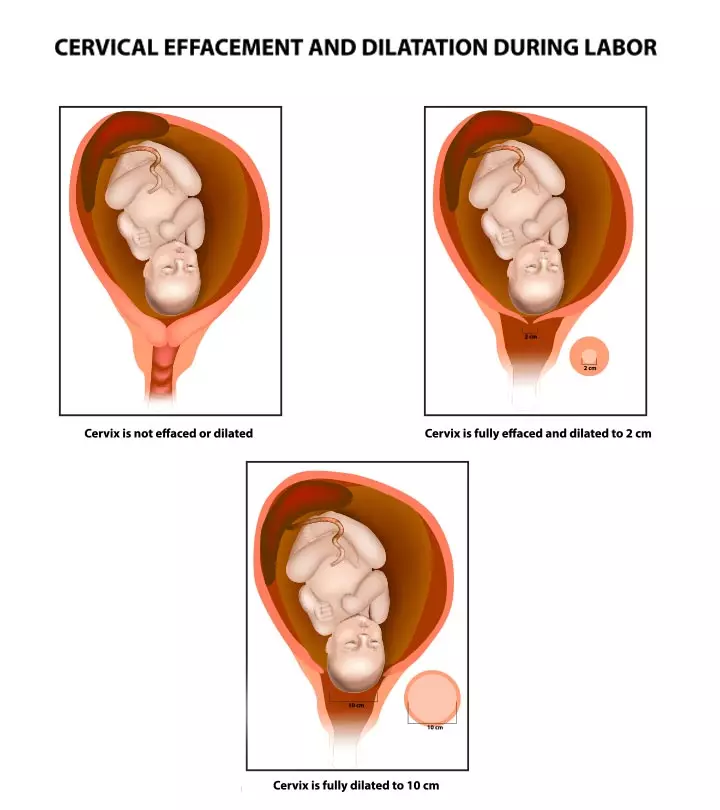
Image: Shutterstock
CervixiThe lowest portion of the uterus that connects to the vagina to form a passage between the two organs. dilation is the opening of the cervix, the neck of the uterus, during childbirth (1). Body changes during the labor process to allow the baby to pass through the birth canal. Although it is exciting to hold the baby, many women may be nervous and worry about the labor pain and delivery near the due date. Knowing these changes may help them to stay calm. Childbirth includes three stages, and cervical dilation is crucial since it allows the baby to come out (2). Vaginal delivery may not be possible if there is no adequate cervical dilation during the labor. Doctors may also use various interventions to dilate the cervix if there is a delay. Read on to learn more about the signs, evaluation, and process of cervix dilation during labor.
Key Pointers
- The cervix dilates or opens due to contractions before labor, unlike effacement, which is the thinning and stretching of the cervix before labor.
- The indicators of cervix dilation include contractions, breaking of water, and discharge of mucus or blood.
- Some natural ways to dilate the cervix are walking, sexual intercourse, and the use of a birthing ball.
What Is Cervix Dilation?
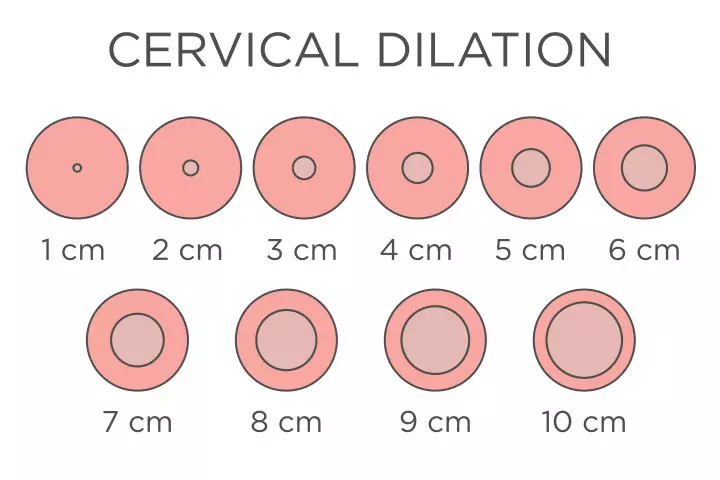
Cervix dilation is the process in which the neck of the uterus gradually opens during the first stage of labor. The cervix dilates (the uterus opens) due to contractions and is a vital part of labor and delivery. The cervical dilation measurement is noted in centimeters. It starts from 1cm and grows to 10cm when it is called a complete dilation (3). Once the cervix is fully dilated, the baby can be delivered through the cervical opening.
If your due date is around the corner and your cervix is dilating, then it could mean you will soon get into labor. Typically, the cervix starts to dilate in the first phase of labor, which is also called the latent phase, where the cervix dilates from 0 to 6 cm (3). This dilation of the cervix is considered one of the early signs of labor, indicating that your body is preparing to welcome your baby. In the active phase, the second phase of stage 1, the dilation of the cervix progresses from 6 to 10 cm (4).
Dilation And Effacement: What Is The Difference?
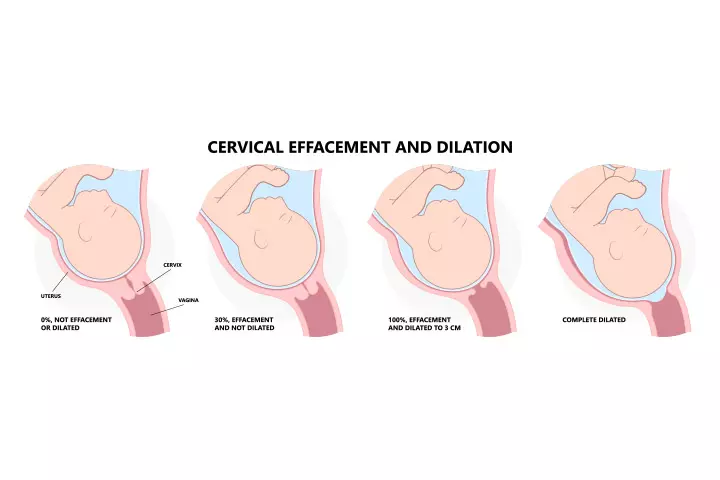
The stretching and thinning of the cervix is called effacement. Cervical effacement is measured in percentage and mostly happens before dilation. The cervix thins and softens at first, and then opens (5). This happens when labor begins, which is usually around week 37. However, in some women, it could happen during week 38 or later.
Usually, in the first pregnancy, the cervix dilates during labor or after the contractions start. And in some cases, cervical effacement and dilation might happen just before the labor (5). As every pregnancy is different, the occurrence of effacement and dilation can differ.
How Do You Know If Your Cervix Is Dilating?
You will be able to notice even the slightest of changes in the body if you are observant as you near the due date. The following signs indicate that the cervix is dilating.
- Lightning crotch: It is the sudden and intense pain experienced in your vagina when your baby descends. Some pregnant women say that the pain feels like a punch in the crotch. When you experience such pain near your due date, it could mean that your baby is positioned for delivery (6).
- Uterine contractions: When contractions are frequent and painful, it is most probably a sign of approaching labor, effacement, and dilation (7). In this stage, cervical dilation and contractions cause the cervix to open from zero to three centimeters.
Kylie, a mother and vlogger, shares her experience of cervical dilation and the symptoms she felt as labor approached. She says, “They (doctors) decided to check me since I was having contractions, and I was three and a half, almost four centimeters dilated…they said it could happen today, tonight, or tomorrow. They advised me to keep monitoring the contractions, and if my water breaks, go straight to the hospital since second babies can arrive much faster (i).” - Ruptured membranes or breaking of water: This generally happens during the active phase of stage one labor. When a gush of water is released, the pressure might open the cervix.

- Mucus plug discharge: Mucus plug works as a seal to your cervix, and protects your little one from bacteria. So when your cervix opens, the mucus plug comes out (8).
- Bloody show: Brown or pink colored discharge could be a result of dilation. If you start noticing some stains, then it might mean your cervix has dilated (8).
If you notice any signs of cervical dilation, contact your healthcare provider right away for advice and support.
 Things to know
Things to knowHow Does Checking Cervix Dilation Help?

Checking cervical dilation helps you to know how close you are to labor and the effective management of labor. When your due date is nearing or has passed, your doctor may check the cervix to see if it is dilated.
A study involving 726 pregnant women assessed whether cervical dilation could predict the timing and likelihood of spontaneous labor at term. The study report states, ” An advanced cervical exam was associated with a 50% increased likelihood of spontaneous labor for each centimeter of dilation. When examined categorically, women with an exam of greater than 1 cm were three times more likely to go into spontaneous labor. At 39 weeks, 60.0% of women who had a cervical exam the previous week of greater than 1 cm went into spontaneous labor in the upcoming week as compared to only 27.9% of those with an exam of less than 1 cm (10).”
Gretchen, a mom who was driven to the hospital in active labor and was 10 cm dilated when her midwife checked her first, shares her childbirth and labor experience. She says, “I have no idea how far along I am. I hear my midwife say she wants to check my dilation so I don’t wear myself out pushing too early.”
Her midwife checked and told her that she was 10 cm dilated. She adds, “I’m not sure what happened after that because another contraction rolls me back to my knees, and I hear my doula’s soft voice in my ear, ‘You’re there. All you have to do now is push your baby out (ii).” Checking cervical dilation in Gretchen’s case helped her midwife determine that she was fully dilated and ready for the pushing stage of labor.
Procedure To Check The Cervix For Dilation
Doctors usually do a cervical exam to check the dilation using their fingers. It is a sterile method that measures the dilation in centimeters (4) (11).
Steps to check cervix dilation: Follow these steps to check if the cervix is dilated.
i. Use two fingers: Index and middle fingers are inserted into the vagina and against the cervix to gauge the opening. Avoid the anal area.
ii. Assess the dilation: The two fingers should feel the cervix and the cervix opening to assess the cervical dilation and cervical length.
According to a meta-analysis, ultrasound may provide a more accurate way to measure cervical dilation and monitor labor progression in the future (12). However, the digital cervical exam is currently the most reliable method for assessing cervical dilation.
You can use the cervix dilation chart to understand the cervix dilation stages and compare your dilation.
Cervix Dilation Chart
The below chart has been taken from the US Operational Obstetrics and Gynecology (11).
| Length in cm | Assessment |
|---|---|
| 1.5cm | One finger fits in tightly and touches the head of the fetus |
| 2cm | One finger is loose, and there is no space for the second finger |
| 3cm | Two fingers fit in tightly inside the cervix |
| 4cm | Two fingers are loose in the cervix |
| 6cm | 2cm of the cervix is palpable on two sides |
| 8cm | 1cm of the cervix is palpable on two sides |
| 9cm | Less than 1cm is left/only anterior lip of cervix felt |
| 10cm | Cervix is not felt around the head of the fetus |
Although professionals generally recommend checking cervical dilation before labor, there are certain cases where they do not suggest it.
When Not To Check Your Cervix During Pregnancy?
If your doctor finds it risky to check cervical dilation, then do not attempt it. Also, if you experience any signs of infection, such as fever or unusual discharge, avoid cervical checks to prevent complications. A cervical dilation examination should only be done when your medical professional has recommended it after assessing you. Otherwise, do not attempt it.
Next, we see if it is possible to dilate the cervix to speed up the labor process.
Are There Ways To Dilate The Cervix?

Yes, there are natural and medical ways to dilate the cervix. To dilate the cervix, it has to be softened (cervical ripening) first. Usually, medical experts prefer waiting for it to happen naturally. But in some cases, it becomes necessary to dilate the cervix and induce labor.
Some of the natural methods include walking, using a birthing ball, taking herbal supplements, indulging in sexual intercourse, and nipple stimulation. Medical methods include medications and medical/surgical procedures such as stripping of the membranes (13).
 Things to know
Things to knowHow Long Does Each Stage Of Labor Last?
Understanding the vital stages of labor is important for expecting mothers, as each stage has different characteristics and time frames. The process of labor is typically divided into three stages (14).
- First stage: In the first stage of labor, also called established labor, the cervix dilates up to about four centimeters, and the contractions become more regular and increase in intensity. If you have your first baby, this stage might last for about eight to 18 hours, whereas, in subsequent pregnancies, it might last for about five to 12 hours.
- Second stage: In this stage, the cervix is fully dilated (to 10cm), and the womb muscles are actively contracting and relaxing, preparing for the final stage of pushing the baby out. Once the urge arises, it transitions into the active phase. This stage lasts about two to three hours, depending on the initiation of the active phase of the labor.
- Third stage: The last and final stage of labor refers to the time when the baby has been delivered, but the mother has yet to release the placenta.
Frequently Asked Questions
1. How long does it take for labor to start after cervical dilation?
The cervix starts dilating during the first stage of labor or early labor. For first-time mothers, it may take hours (approx. 8-18 hrs) to move on to active labor. For subsequent deliveries, the period of early labor reduces (15).
2. What are the symptoms of cervix dilation?
The symptoms of cervix dilation during pregnancy can include increased vaginal discharge, frequent and intense contractions, and pelvic pressure (8).
3. Which foods can help the cervix dilate?
There is no scientific evidence that suggests specific foods can directly cause the cervix to dilate. The dilation of the cervix is a complex process influenced by various factors, including hormone levels, pressure from the fetus’s head, and the strength and frequency of contractions. You may try some natural or at-home cervical dilation methods like acupuncture, castor oil, or herbal supplements. However, you should consult your healthcare provider before using any methods (9).
4. Can I take a bath after my cervix is dilated?
It is best to avoid taking a bath during labor as it can slow down or halt contractions (16). But you take a bath after your cervix has dilated if you have been cleared to do so by your healthcare provider and you are not in active labor. It is important to remember that each pregnancy and birth is unique, and what is safe for one person may not be safe for another.
Cervix dilation is the opening of the cervix during birth or labor to facilitate childbirth. The cervix dilates gradually from the first phase of labor till delivery. If the cervical dilation is inadequate, doctors may recommend cesarean section delivery. Sudden pain called lightning crotch, water breaks, and intense uterine contractions can be associated with cervical dilation near delivery. You may check the cervical dilation using two fingers if your doctor permits it. The use of birthing balls, walking, sexual intercourse, and nipple stimulation are some of the natural ways to dilate the cervix for delivery.
Infographic: What Are The Risks Of Cervical Ripening?
Cervical ripening is a process of softening and opening the cervix for childbirth. Nonpharmacologic methods, medications, and certain devices are used for cervical ripening. Read through the infographic to know the common risks of cervical ripening. Illustration: Momjunction Design Team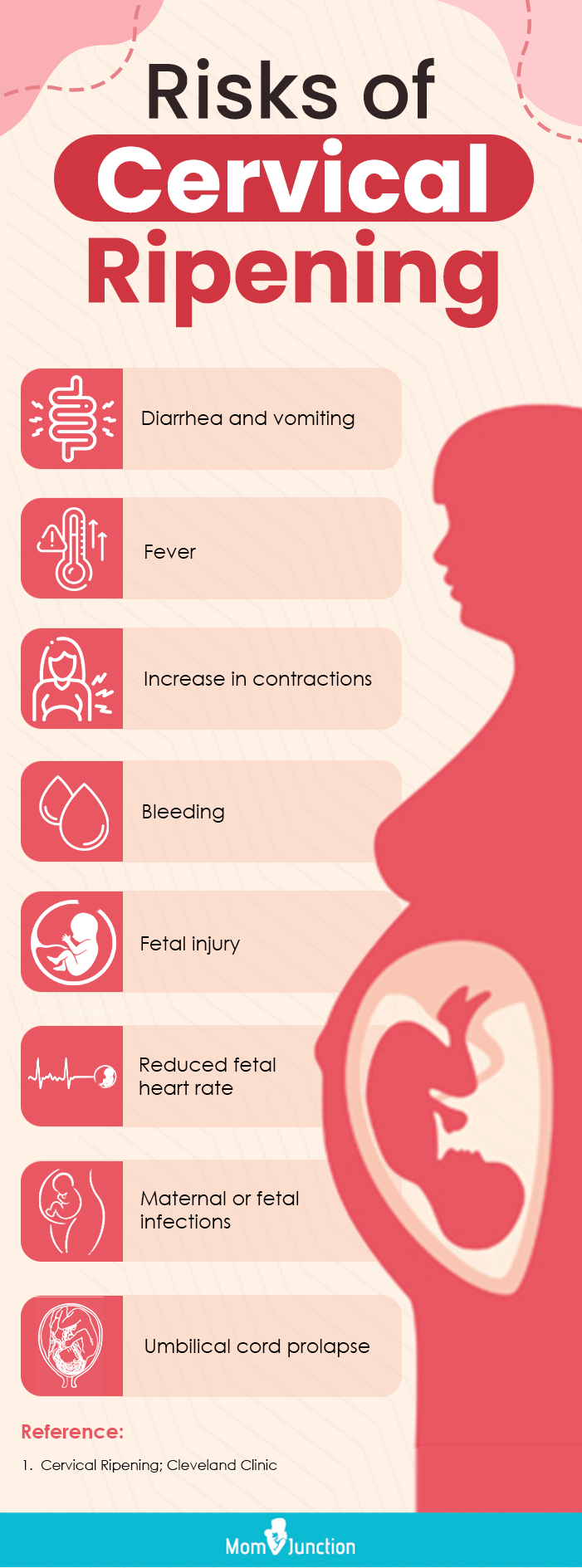
Illustration: Cervix Dilation Chart: Signs Stages And Procedure To Check
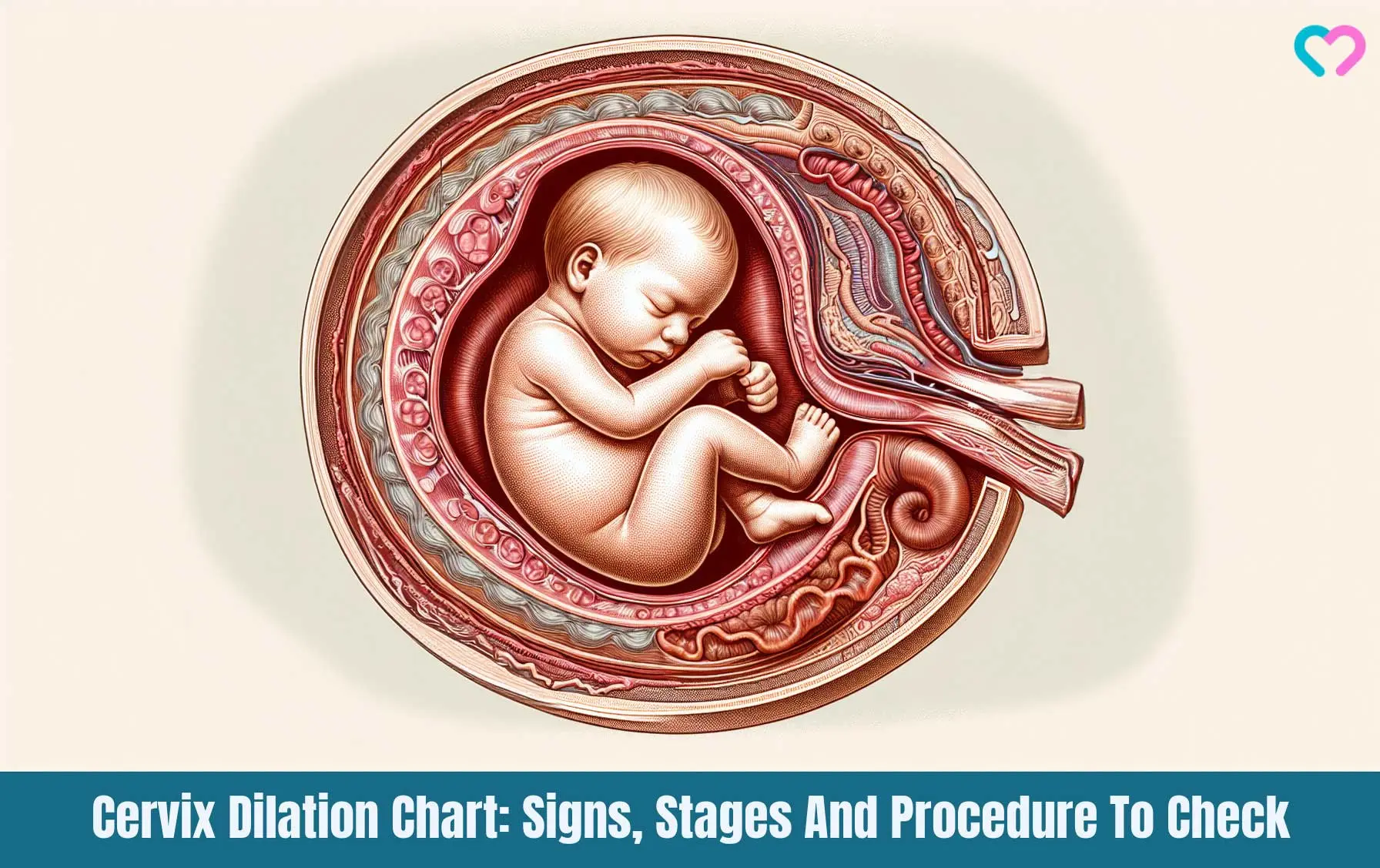
Image: Dall·E/MomJunction Design Team
Personal Experience: Sources
MomJunction articles include first-hand experiences to provide you with better insights through real-life narratives. Here are the sources of personal accounts referenced in this article.
i. AM I IN LABOR? (5cm dilated, lost mucus plug) || CROSSFAM VLOGS.
https://www.youtube.com/watch?feature=shared&v=XzQttb0KnDA
ii. A birth story;
https://clovescorner.blogspot.com/2011/12/birth-story.html
References
- Cervical Effacement and Dilatation.
https://www.columbiadoctors.org/health-library/special/cervical-effacement-dilatation/ - Stages of Labor.
https://www.ncbi.nlm.nih.gov/books/NBK544290/ - What Happens During Labor.
https://www.bidmc.org/centers-and-departments/obstetrics-and-gynecology/programs-and-services/pregnancy/labor-and-delivery/stages-of-labor# - Physiology, Cervical Dilation.
https://www.ncbi.nlm.nih.gov/books/NBK557582/ - Cervical Effacement and Dilatation.
https://www.uofmhealth.org/health-library/zx3441/Accessed#:~:text=Effacement%20means%20that%20the%20cervix - Braxton-Hicks or Real Labor Contractions?
https://epigee.org/braxton-hicks-or-labor.html - Recognizing Premature Labor.
https://www.ucsfhealth.org/education/recognizing-premature-labor - How to Tell When Labor Begins.
https://www.acog.org/womens-health/faqs/How-to-Tell-When-Labor-Begins?utm_source=redirect&utm_medium=web&utm_campaign=otn - Cervical Ripening.
https://my.clevelandclinic.org/health/procedures/22165-cervical-ripening - Danielle Panelli et.al; (2018); 405: Utilizing cervical dilation to predict labor onset: A tool for elective induction counseling.
https://www.ajog.org/article/S0002-9378(17)31579-X/fulltext - Labor and Delivery.
https://www.operationalmedicine.org/ed2/Enhanced/LandD/DilatationandEffacement.htm - Margherita Brancadoro et.al; (2018); Devices for Measuring Cervical Dilation During Labor: Systematic Review and Meta-analysis.
https://pubmed.ncbi.nlm.nih.gov/29701868/ - Methods for Cervical Ripening and Induction of Labor.
https://www.aafp.org/pubs/afp/issues/2003/0515/p2123.html - The stages of labour.
https://www.tommys.org/pregnancy-information/giving-birth/stages-labour - The stages of labour and birth.
https://www.nhs.uk/pregnancy/labour-and-birth/what-happens/the-stages-of-labour-and-birth/ - Margareta Eriksson BS et.al; (1997); Early or late bath during the first stage of labour: A randomised study of 200 women.
https://www.sciencedirect.com/science/article/abs/pii/S026661389790005X#:~:text=Key%20conclusions%20and%20implications%20for
Community Experiences
Join the conversation and become a part of our nurturing community! Share your stories, experiences, and insights to connect with fellow parents.
Read full bio of Dr. Sangeeta Agrawal
Read full bio of Dr Bisny T. Joseph
Read full bio of Rebecca Malachi
Read full bio of Reshmi Das





















